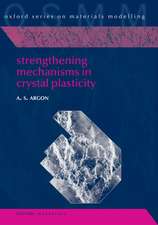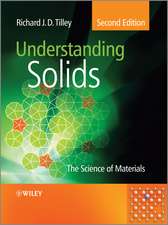Molecular Solid State Physics
Autor George G. Hallen Limba Engleză Paperback – 8 mai 1991
Preț: 380.84 lei
Nou
Puncte Express: 571
Preț estimativ în valută:
72.88€ • 77.93$ • 60.76£
72.88€ • 77.93$ • 60.76£
Carte tipărită la comandă
Livrare economică 18 aprilie-02 mai
Preluare comenzi: 021 569.72.76
Specificații
ISBN-13: 9783540537922
ISBN-10: 3540537929
Pagini: 168
Ilustrații: X, 151 p.
Dimensiuni: 155 x 235 x 9 mm
Greutate: 0.25 kg
Ediția:Softcover reprint of the original 1st ed. 1991
Editura: Springer Berlin, Heidelberg
Colecția Springer
Locul publicării:Berlin, Heidelberg, Germany
ISBN-10: 3540537929
Pagini: 168
Ilustrații: X, 151 p.
Dimensiuni: 155 x 235 x 9 mm
Greutate: 0.25 kg
Ediția:Softcover reprint of the original 1st ed. 1991
Editura: Springer Berlin, Heidelberg
Colecția Springer
Locul publicării:Berlin, Heidelberg, Germany
Public țintă
GraduateCuprins
1 Close-Packed Crystals.- 1-1 Introduction.- 1-2 Some simple lattices.- 1-3 The seven crystal systems.- 1-4 The packing of spheres.- 1-5 Forces between atoms.- 1-6 Scaling of the potential.- 1-7 Surface energies.- 1-8 Packing of ellipsoids.- 1-9 Sphere-like molecules and the plastic phase.- 1-10 Origin of the repulsive term.- 2 Ionic Crystals.- 2-1 Introduction.- 2-2 Alkali halide crystal structures.- 2-3 Electrostatic forces.- 2-4 Ionic radii.- 2-5 Scaling the energy.- 2-6 The Pauling rules for ionic crystals.- 2-7 Ferroelectrics.- 2-8 Superconductors.- 2-9 Surface energy.- 2-10 Defects.- 2-11 Colour centres.- 2-12 Ionic melts.- 2-13 Covalent and ionic character.- 3 Molecular Crystals.- 3-1 Introduction.- 3-2 Forces between molecules.- 3-3 Crystal structure.- 3-4 The paraffin crystals.- 3-5 Glass.- 3-6 Molecular vibrations in crystals.- 3-7 Excitons.- 3-8 Crystal engineering.- 4 Valence Crystals.- 4-1 Introduction.- 4-2 Equivalent orbital model of polymers.- 4-3 The model of trans-poly-acetylene.- 4-4 The diamond crystal 6.- 4-5 Elastic constants for diamond.- 4-6 A vacancy in diamond.- 4-7 Semi-conductors.- 4-8 Impurities and doping.- 4-9 The np junction.- 4-10 The pnp transistor.- 4-11 Excited states of trans-poly-acetylene.- 4-12 The SSH model of a soliton.- 5 Metals.- 5-1 Introduction.- 5-2 Small clusters and the Jahn-Teller theorem.- 5-3 Clusters of metal atoms.- 5-4 Larger clusters.- 5-5 Fractal clusters.- 5-6 Corrosion.- 5-7 Metal cohesion.- 5-8 Atom to metal transition.- 5-9 The Hume-Rothery rules for alloys.- 6 Surfaces.- 6-1 Introduction.- 6-2 The surface lattice.- 6-3 Energy of an atom approaching a surface.- 6-4 Clusters as surface models.- 6-5 Oxygen on graphite.- 6-6 Intercalation and graphite fluoride.- 6-7 The McCreery-Wolken model of adsorption.- 6-8 Oxidation of silicon.- 6-9 The absorption of hydrogen in palladium.- 6-10 Penrose tiling.- 7 Cooperative effects.- 7-1 Introduction.- 7-3 The square lattice.- 7-4 Alloys.- 7-5 Melting.- 7-6 Nematic liquid crystals.- 7-7 The smectic-A phase of liquid crystals.- 7-8 Ferromagnets.- 7-9 Ferroelectrics.- 7-10 Ferroelasticity.- Appendix 1 Lattice sums.- Appendix 2 The phase difference method.- Appendix 3 Impurities in bands.- Appendix 4 Second quantization.- Appendix 5 Improved semi-empirical methods.- Appendix 6 The LEPS interaction.- Appendix 7 Green’s functions.- Appendix 8 Atomic units.- Author Index.















